Assessing the Theoretical, Minimal Intervention Potential of Floating Solar in Greece: A Policy-Oriented Planning Exercise on Lentic Water Systems of the Greek Mainland
Abstract
1. Introduction
2. Materials and Methods
2.1. Problem Definition
2.2. Input Data and Data Processing
2.3. Set of Equations and Assumptions
3. Results
3.1. Lentic Water System Level of Analysis
3.2. Regional Level of Analysis
3.3. Strategic Planning Scenarios
3.4. Regional Planning Results and Strategic Roadmaps’ Directions
- Prioritization of installations in regions with the highest potential of floating solar capacity and/or number of available lentic water systems, and/or proportional development per region under a potential-driven approach per different strategic scenario;
- Prioritization of small-scale, pilot installations for demonstration purposes under the adoption of a bottom-up transition approach, i.e., from the distributed to the centralized generation scenario;
- Prioritization of centralized installations implying a greater impact that may accordingly trigger a roll-out effect under a top-down transition approach;
- Prioritization of cooperative schemes (e.g., district-level cooperatives) for the exploitation of the available potential through the provision of relevant state incentives;
- Prioritization of artificial lentic water systems over natural ones in order to gain a better understanding of system environmental impacts, starting from ecosystems of comparably lower vulnerability, offering also the opportunity for the exploitation of already existing infrastructure (e.g., in the case of lentic water systems where hydropower plants are operated).
4. Conclusions
Author Contributions
Funding
Data Availability Statement
Conflicts of Interest
References
- Greek Ministry of Environment and Energy. National Climate & Energy Plan. 2023. Available online: https://commission.europa.eu/system/files/2023-11/GREECE%20-%20DRAFT%20UPDATED%20NECP%202021-2030%20EL.pdf (accessed on 10 September 2023).
- Díaz, H.; Soares, C.G. Review of the current status, technology and future trends of offshore wind farms. Ocean Eng. 2020, 209, 107381. [Google Scholar] [CrossRef]
- Vidović, V.; Krajačić, G.; Matak, N.; Stunjek, G.; Mimica, M. Review of the potentials for implementation of floating solar panels on lakes and water reservoirs. Renew. Sustain. Energy Rev. 2023, 178, 113237. [Google Scholar] [CrossRef]
- Nobre, R.; Boulêtreau, S.; Colas, F.; Azemar, F.; Tudesque, L.; Parthuisot, N.; Favriou, P.; Cucherousset, J. Potential ecological impacts of floating photovoltaics on lake biodiversity and ecosystem functioning. Renew. Sustain. Energy Rev. 2023, 188, 113852. [Google Scholar] [CrossRef]
- Vaissière, A.C.; Levrel, H.; Pioch, S.; Carlier, A. Biodiversity offsets for offshore wind farm projects: The current situation in Europe. Mar. Policy 2014, 48, 172–183. [Google Scholar] [CrossRef]
- Gasparatos, A.; Doll, C.N.H.; Esteban, M.; Ahmed, A.; Olang, T.A. Renewable energy and biodiversity: Implications for transitioning to a Green Economy. Renew. Sustain. Energy Rev. 2017, 70, 161–184. [Google Scholar] [CrossRef]
- Lopes, C.M.P.; Neto, S.A.; Branco, D.A.C.; De Freitas, M.A.V.; Fidelis, N.S. Water-energy nexus: Floating photovoltaic systems promoting water security and energy generation in the semiarid region of Brazil. J. Clean. Prod. 2020, 273, 122010. [Google Scholar] [CrossRef]
- Bax, V.; Van de Lageweg, W.I.; Van den Berg, B.; Hoosemans, R.; Terpstra, T. Will it float? Exploring the social feasibility of floating solar energy infrastructure in the Netherlands. Energy Res. Soc. Sci. 2022, 89, 102569. [Google Scholar] [CrossRef]
- Santafé, M.R.; Soler, J.B.T.; Romero, F.J.S.; Gisbert, P.S.F.; Gozálvez, J.J.F.; Gisbert, C.M.F. Theoretical and experimental analysis of a floating photovoltaic cover for water irrigation reservoirs. Energy 2014, 67, 246–255. [Google Scholar] [CrossRef]
- Sahu, A.; Yadav, N.; Sudhakar, K. Floating photovoltaic power plant: A review. Renew. Sustain. Energy Rev. 2016, 66, 815–824. [Google Scholar] [CrossRef]
- Liu, L.; Wang, Q.; Lin, H.; Li, H.; Sun, Q.; Wennersten, R. Power Generation Efficiency and Prospects of Floating Photovoltaic Systems. Energy Procedia 2017, 105, 1136–1142. [Google Scholar] [CrossRef]
- Oliveira-Pinto, S.; Stokkermans, J. Assessment of the potential of different floating solar technologies—Overview and analysis of different case studies. Energ. Conv. Manag. 2020, 211, 112747. [Google Scholar] [CrossRef]
- Ramanan, C.J.; Lim, K.H.; Kurnia, J.C.; Roy, S.; Bora, B.J.; Medhi, B.J. Design study on the parameters influencing the performance of floating solar PV. Renew. Energ. 2024, 223, 120064. [Google Scholar]
- Ramanan, C.J.; Lim, K.H.; Kurnia, J.C.; Roy, S.; Bora, B.J.; Medhi, B.J. Towards sustainable power generation: Recent advancements in floating photovoltaic technologies. Renew. Sustain. Energy Rev. 2024, 194, 114322. [Google Scholar]
- International Renewable Energy Agency. Energy from the Sea: An Action Agenda for Deploying Offshore Renewables Worldwide. 2021. Available online: https://www.irena.org/events/2021/May/An-ActionAgenda-for-Deploying-Offshore-Renewables-Worldwide (accessed on 10 September 2023).
- Trapani, K.; Santafé, M.R. A review of floating photovoltaic installations: 2007–2013. Prog. Photovolt. 2014, 23, 524–532. [Google Scholar] [CrossRef]
- Huang, G.; Tang, Y.; Chen, X.; Chen, M.; Jiang, Y. A Comprehensive Review of Floating Solar Plants and Potentials for Offshore Applications. J. Mar. Sci. Eng. 2023, 11, 2064. [Google Scholar] [CrossRef]
- Jin, Y.; Hu, S.; Ziegler, A.D.; Gibson, L.; Campbell, J.E.; Xu, R.; Chen, D.; Zhu, K.; Zheng, Y.; Ye, B.; et al. Energy production and water savings from floating solar photovoltaics on global reservoirs. Nat. Sustain. 2023, 6, 865–874. [Google Scholar] [CrossRef]
- Bai, B.; Xiong, S.; Ma, X.; Liao, X. Assessment of floating solar photovoltaic potential in China. Renew. Energy 2024, 220, 119572. [Google Scholar] [CrossRef]
- Kulat, M.I.; Tosun, K.; Karaveli, A.B.; Yucel, I.; Akinoglu, B.G. A sound potential against energy dependency and climate change challenges: Floating photovoltaics on water reservoirs of Turkey. Renew. Energy 2023, 206, 694–709. [Google Scholar] [CrossRef]
- Muñoz-Cerón, E.; Osorio-Aravena, J.C.; Rodríguez-Segura, F.J.; Frolova, M.; Ruano-Quesada, A. Floating photovoltaics systems on water irrigation ponds: Technical potential and multi-benefits analysis. Energy 2023, 271, 127039. [Google Scholar] [CrossRef]
- Gelaro, R.; McCarty, W.; Suárez, M.J.; Todling, R.; Molod, A.; Takacs, L.; Randles, C.A.; Darmenov, A.; Bosilovich, M.G.; Reichle, R.; et al. The Modern-Era Retrospective Analysis for Research and Applications, Version 2 (MERRA-2). J. Climate 2017, 30, 5419–5454. [Google Scholar] [CrossRef]
- Kichou, S.; Skandalos, N.; Wolf, P. Floating photovoltaics performance simulation approach. Heliyon 2022, 8, e11896. [Google Scholar] [CrossRef] [PubMed]
- Hellenic Association of Photovoltaic Companies. Greek Photovoltaic Market Statistical Data for 2023. 2024. Available online: https://helapco.gr/xoorigle/2024/02/pv-stats_greece_2023_19Feb2024.pdf (accessed on 25 February 2024).
- Renewable Energy Sources Operator & Guarantees of Origin. Summary Report on RES and CHP. 2023. Available online: https://www.dapeep.gr/dimosieuseis/sinoptiko-pliroforiako-deltio-ape/ (accessed on 23 February 2024).
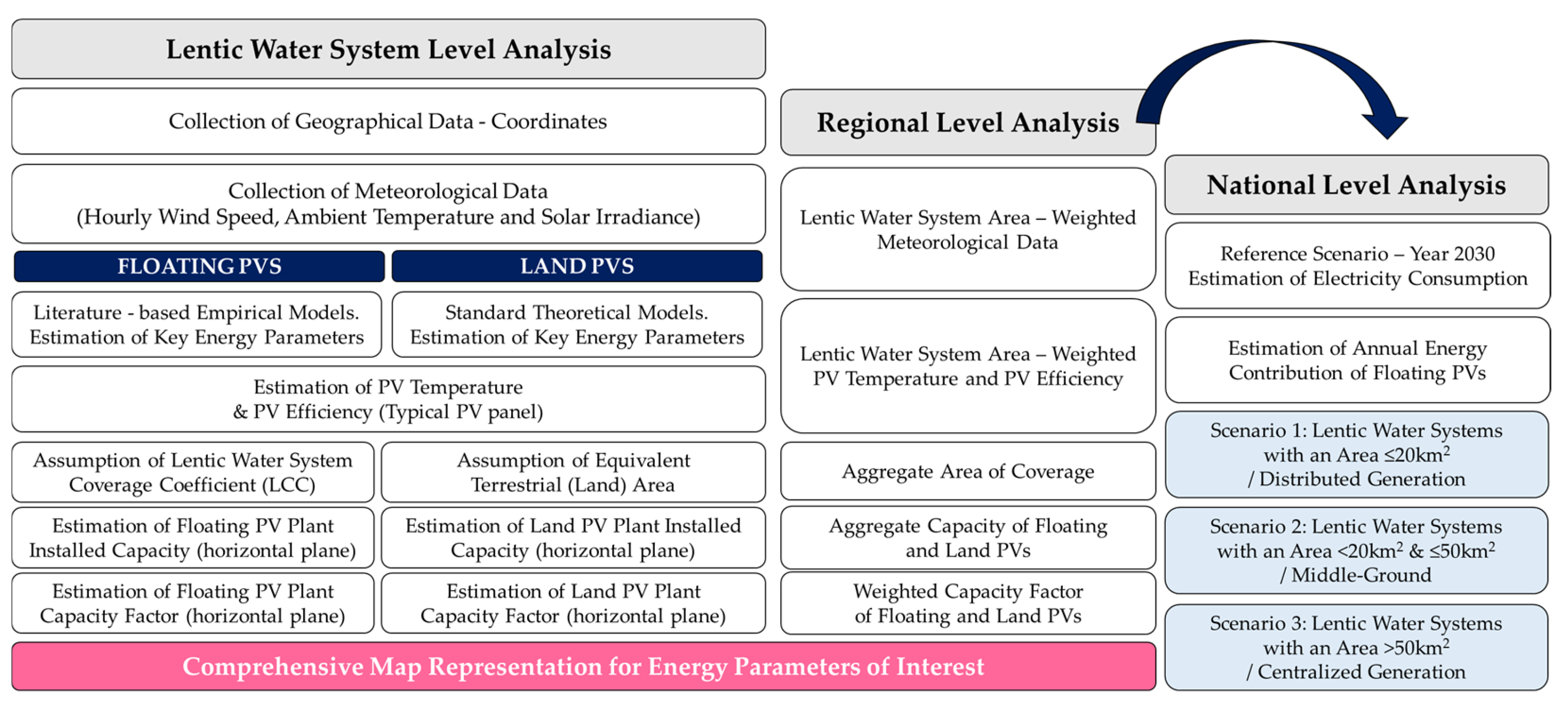
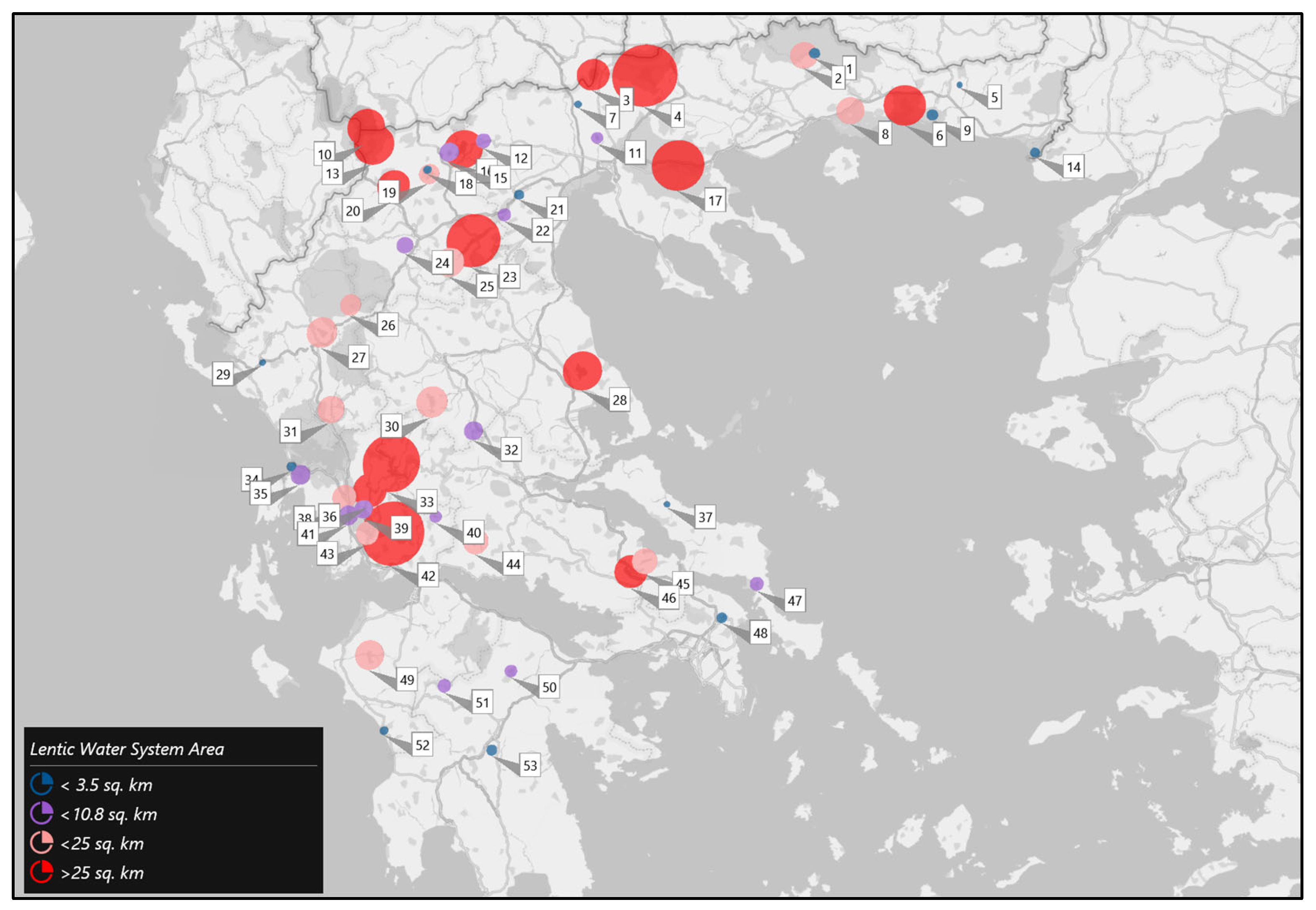
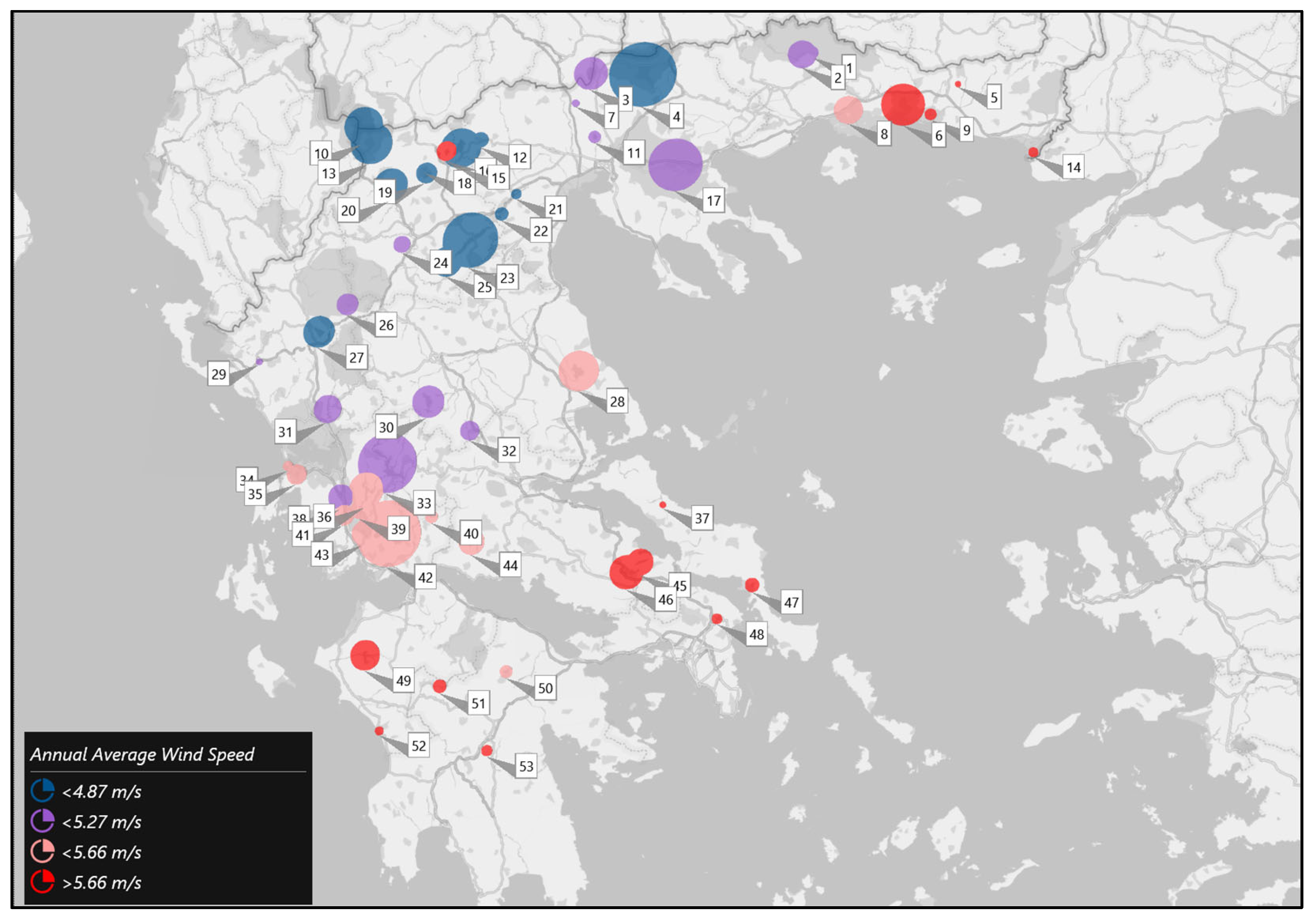
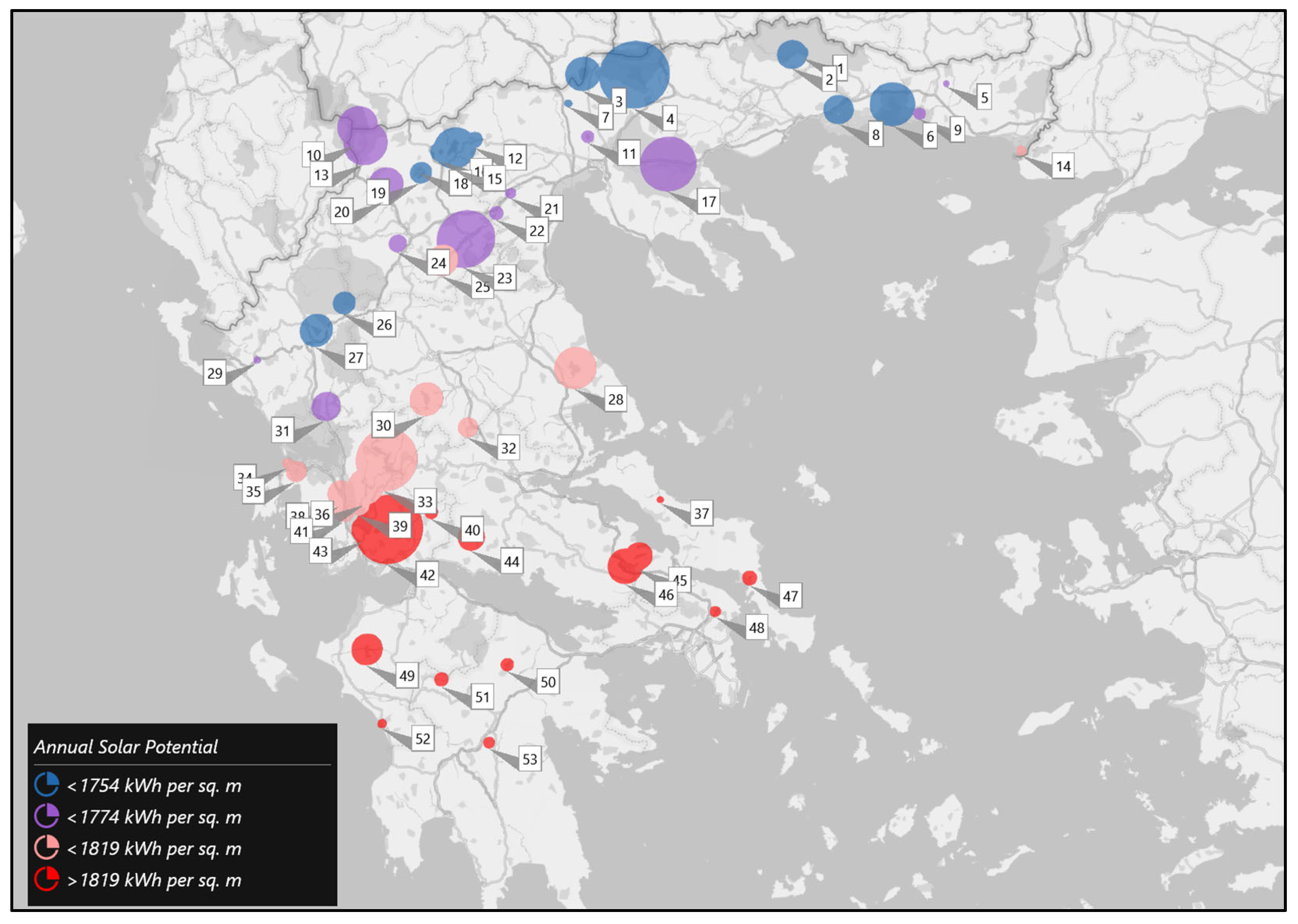
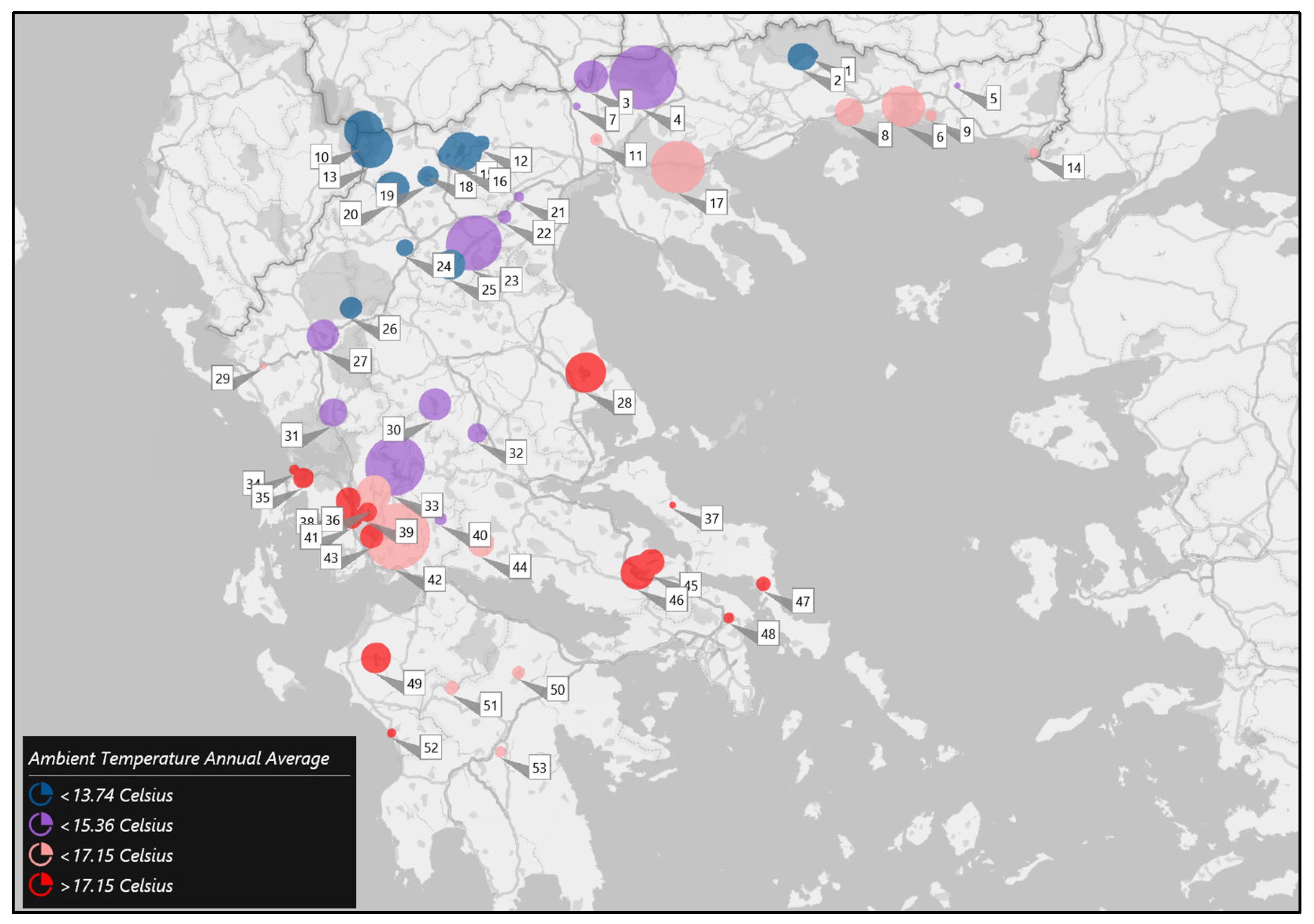
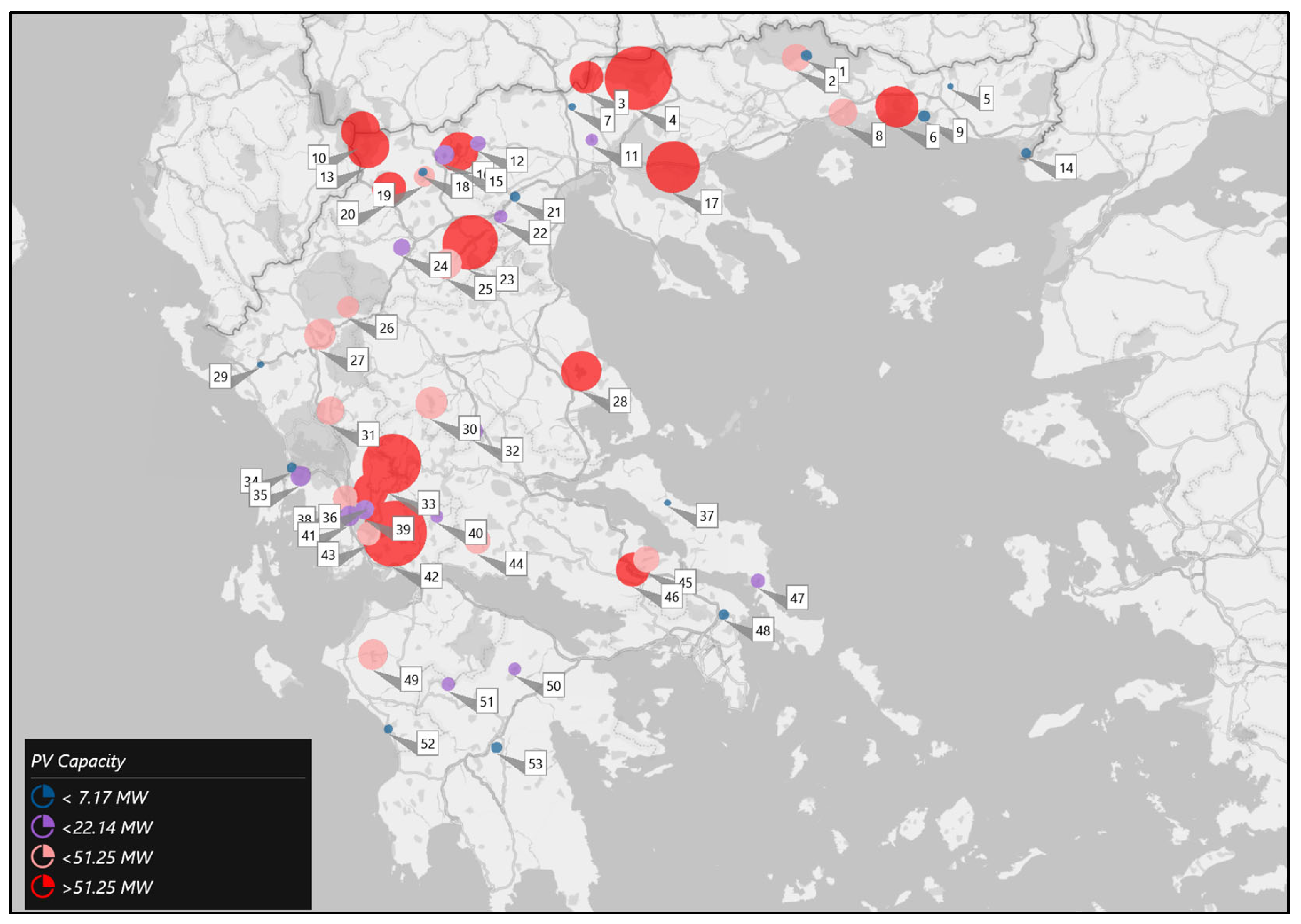
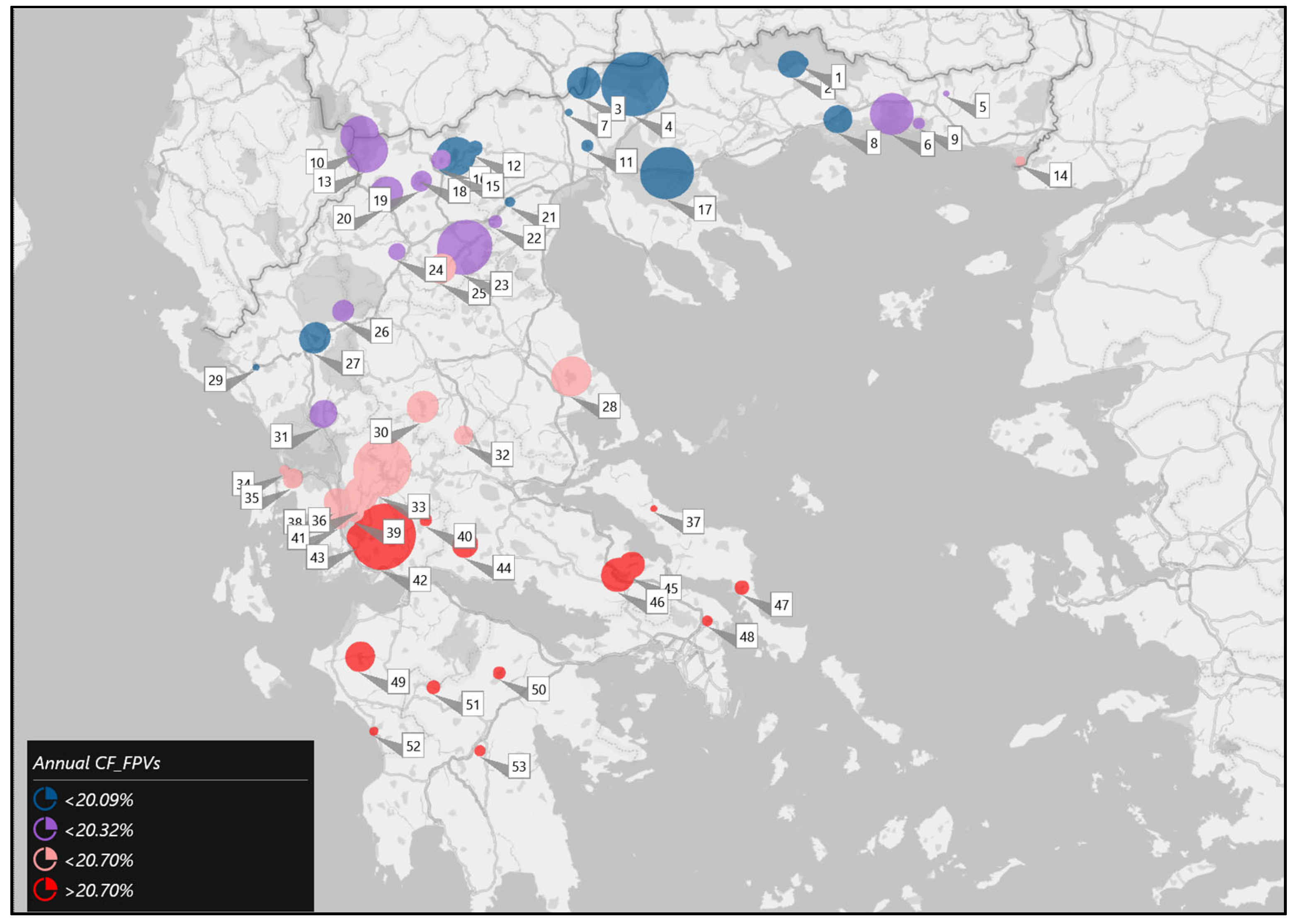
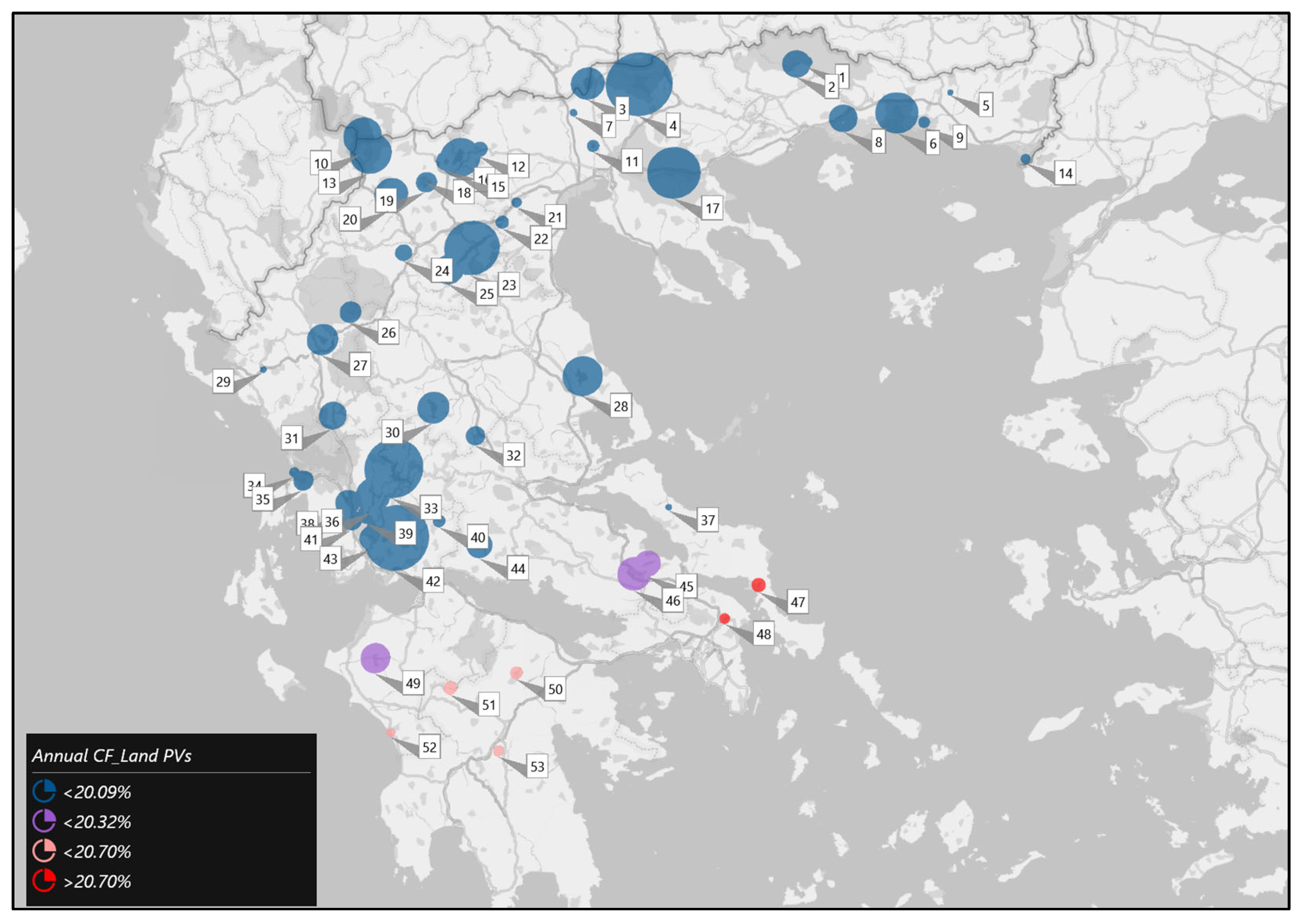

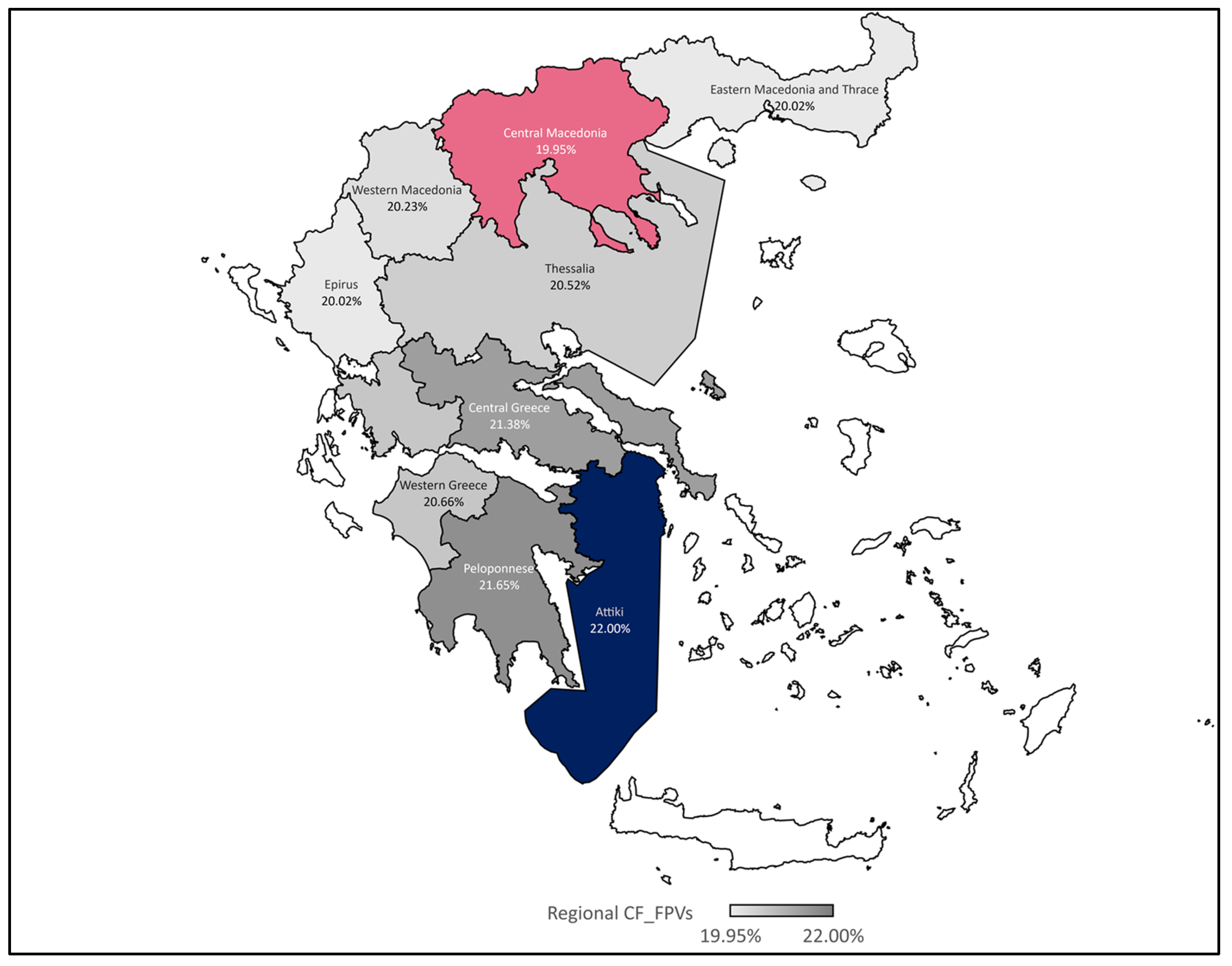
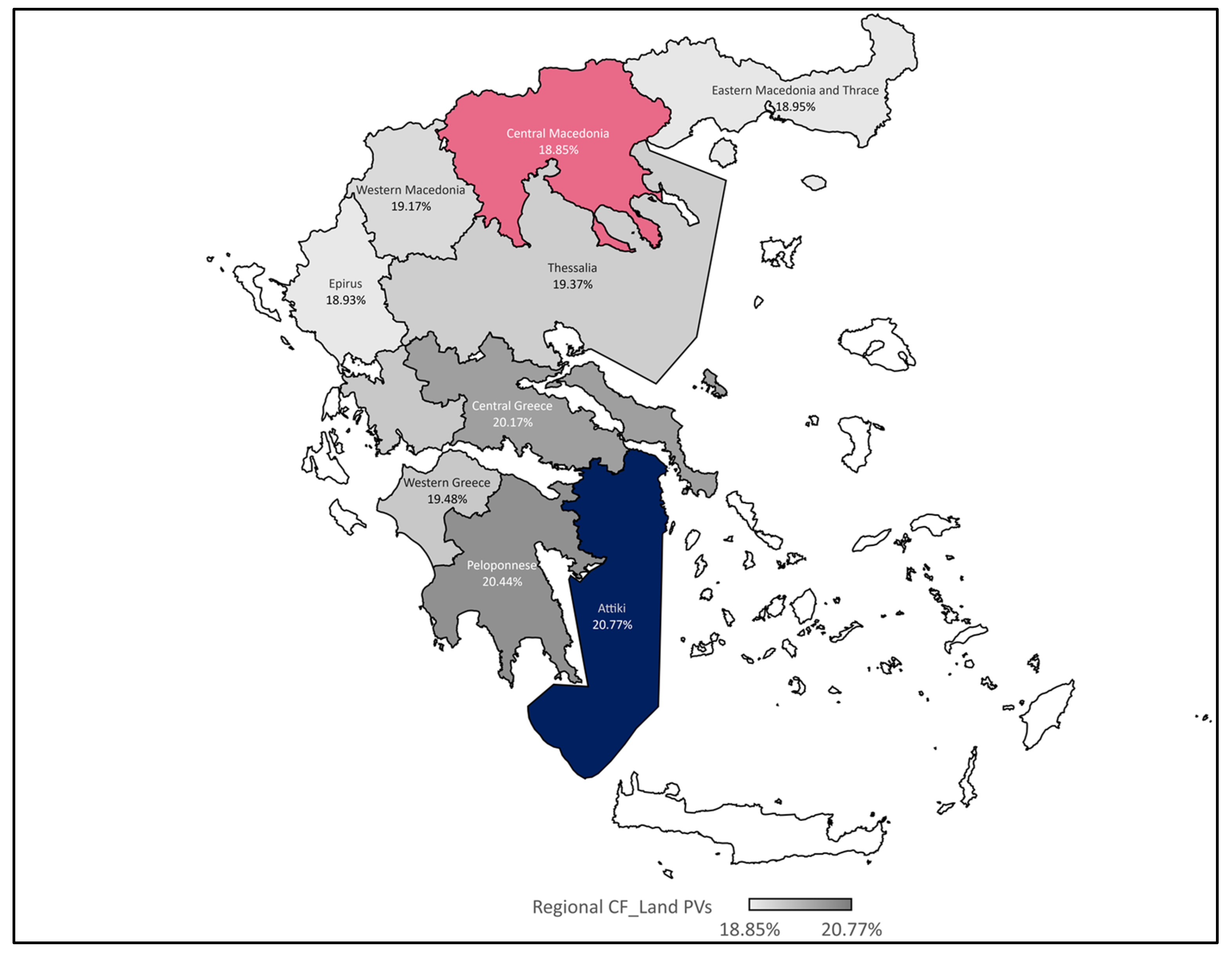
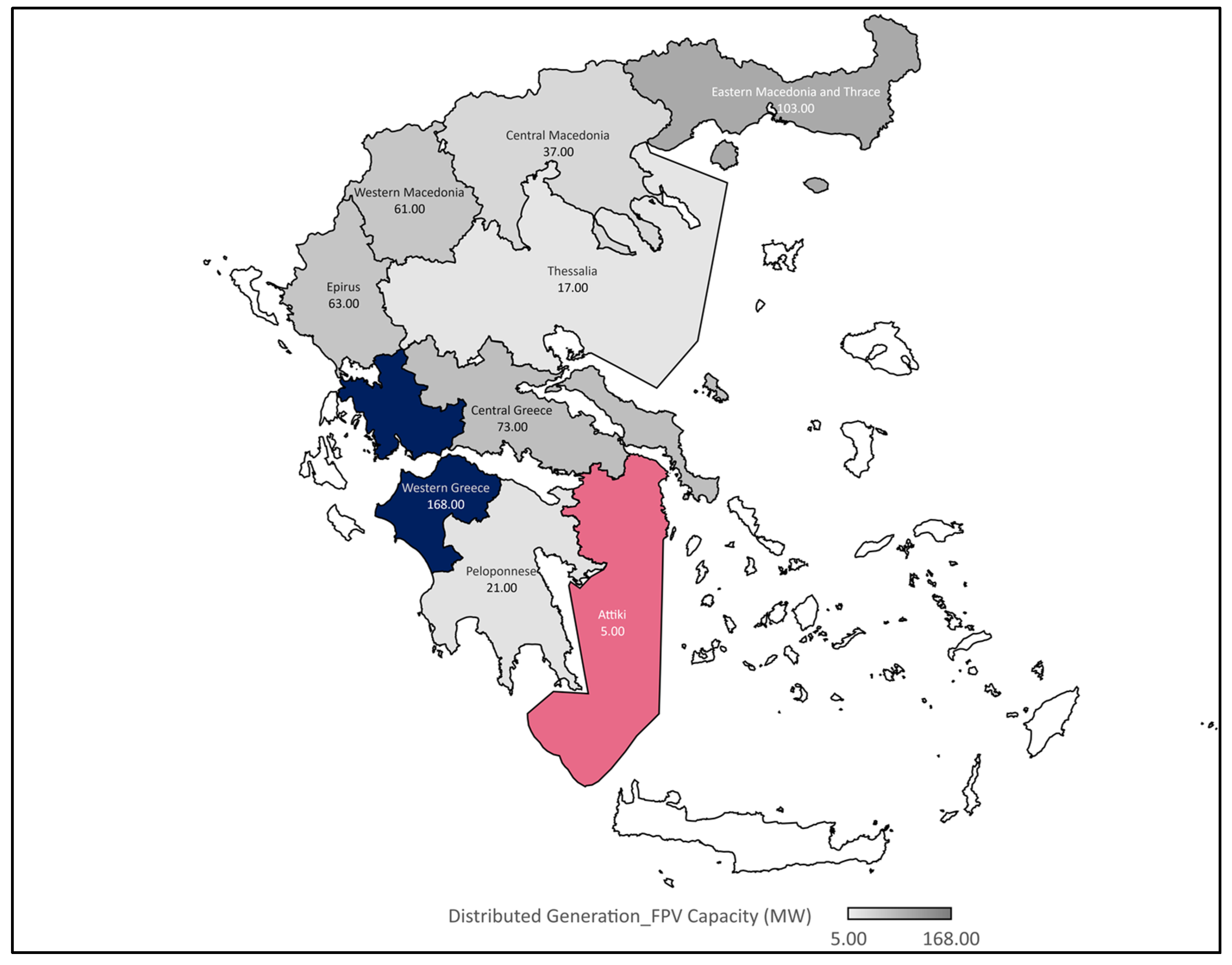
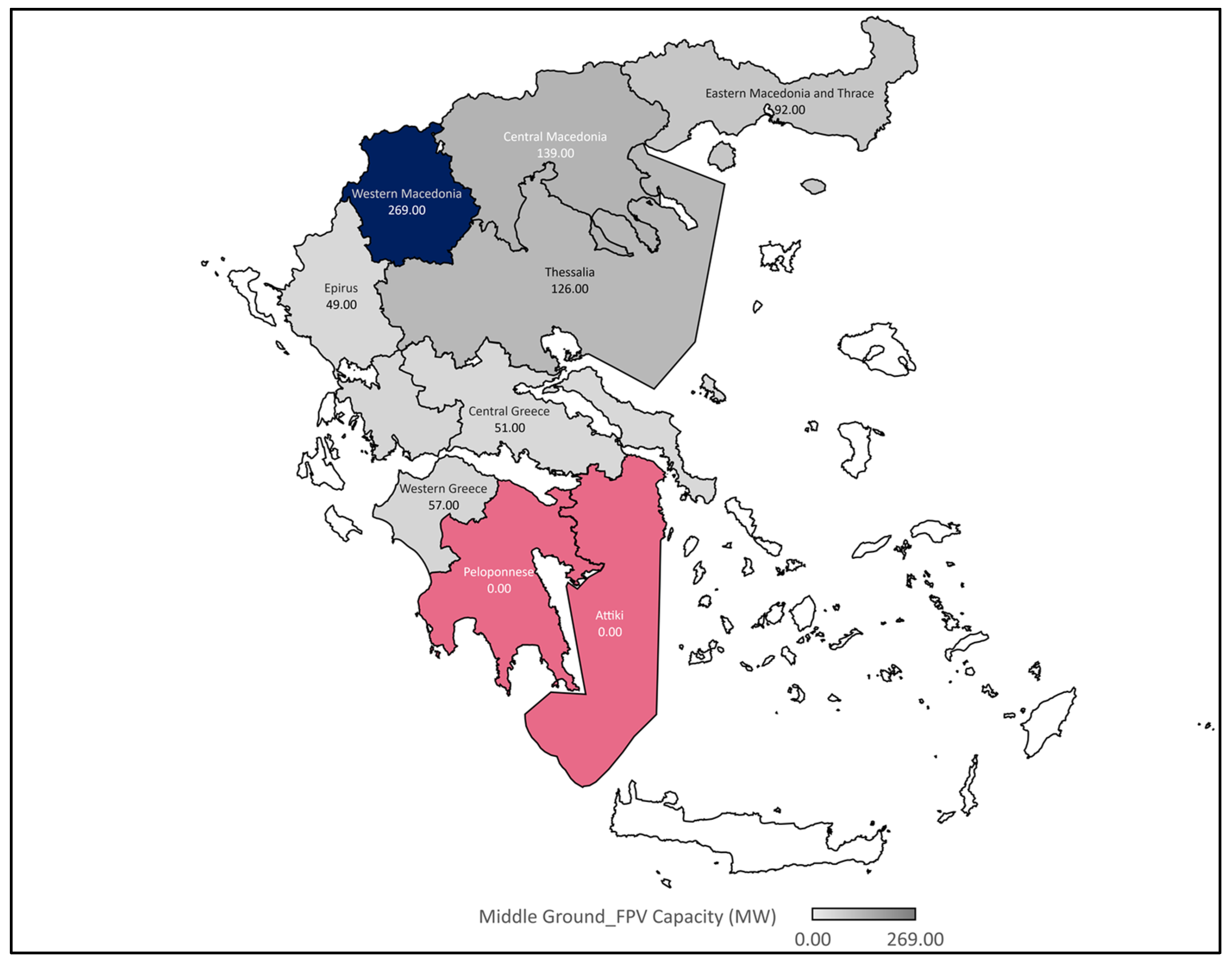
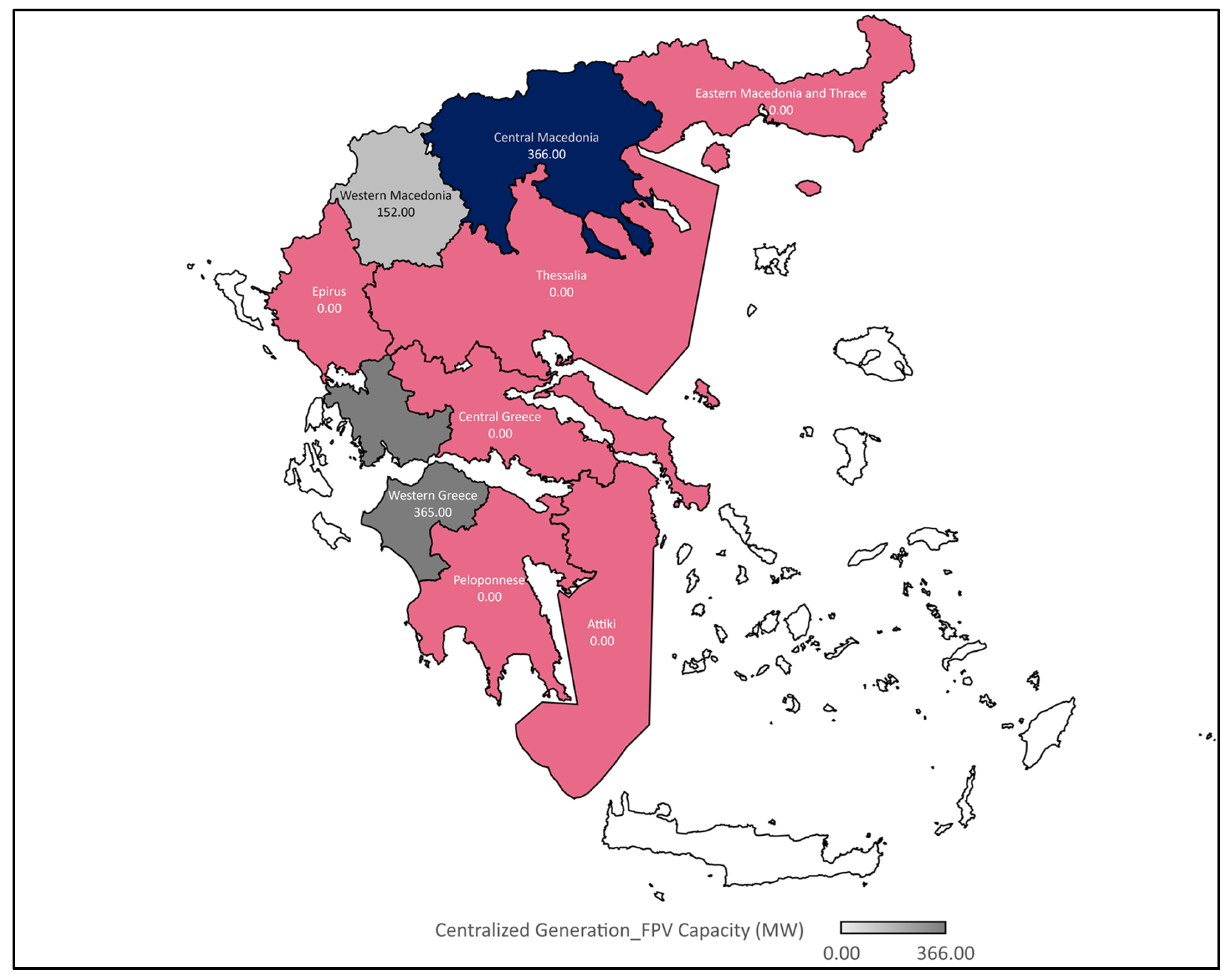


| A/A | Lentic Water System | Category | Region | Area (km2) | Lat. | Lon. |
|---|---|---|---|---|---|---|
| 1 | Platanovrisi | Artificial | Eastern Macedonia & Thrace | 3.20 | 41.350 | 24.423 |
| 2 | Thisavros | Artificial | Eastern Macedonia & Thrace | 20.00 | 41.338 | 24.344 |
| 3 | Doirani | Natural | Central Macedonia | 28.00 | 41.211 | 22.744 |
| 4 | Kerkini | Artificial | Central Macedonia | 109.96 | 41.210 | 23.141 |
| 5 | Gratini | Artificial | Eastern Macedonia & Thrace | 1.00 | 41.163 | 25.520 |
| 6 | Vistonida | Natural | Eastern Macedonia & Thrace | 45.00 | 41.040 | 25.111 |
| 7 | Arzani | Artificial | Central Macedonia | 1.40 | 41.031 | 22.648 |
| 8 | Chrysoupolis | Natural | Eastern Macedonia & Thrace | 20.00 | 41.008 | 24.705 |
| 9 | Ismarida | Natural | Eastern Macedonia & Thrace | 3.40 | 40.984 | 25.317 |
| 10 | Megali Prespa | Natural | Western Macedonia | 37.60 | 40.871 | 21.028 |
| 11 | Pikrolimni | Natural | Central Macedonia | 3.70 | 40.833 | 22.814 |
| 12 | Agra-Vriton | Artificial | Central Macedonia | 6.00 | 40.804 | 21.948 |
| 13 | Mikri Prespa | Natural | Western Macedonia | 43.50 | 40.766 | 21.108 |
| 14 | Nymfon | Natural | Eastern Macedonia & Thrace | 2.40 | 40.761 | 26.078 |
| 15 | Vegoritida | Natural | Central Macedonia | 40.00 | 40.752 | 21.802 |
| 16 | Petron | Natural | Western Macedonia | 10.00 | 40.732 | 21.697 |
| 17 | Volvi | Natural | Central Macedonia | 68.60 | 40.678 | 23.435 |
| 18 | Zazari | Natural | Western Macedonia | 2.00 | 40.625 | 21.546 |
| 19 | Chimaditida | Natural | Western Macedonia | 10.80 | 40.601 | 21.560 |
| 20 | Kastoria | Natural | Western Macedonia | 28.00 | 40.525 | 21.298 |
| 21 | Agias Varvaras | Artificial | Central Macedonia | 2.60 | 40.491 | 22.260 |
| 22 | Sfikia | Artificial | Central Macedonia | 4.30 | 40.373 | 22.163 |
| 23 | Polyfitos | Artificial | Western Macedonia | 74.00 | 40.218 | 21.948 |
| 24 | Agios Georgios | Artificial | Western Macedonia | 7.00 | 40.182 | 21.435 |
| 25 | Ilarionas | Artificial | Western Macedonia | 21.90 | 40.090 | 21.787 |
| 26 | Aoos | Artificial | Epirus | 11.40 | 39.828 | 21.074 |
| 27 | Pamvotida | Natural | Epirus | 24.00 | 39.666 | 20.883 |
| 28 | Karla | Artificial | Thessaly | 37.37 | 39.494 | 22.829 |
| 29 | Hotkova | Natural | Epirus | 1.07 | 39.481 | 20.459 |
| 30 | Plastira | Artificial | Thessaly | 24.00 | 39.297 | 21.753 |
| 31 | Pournari | Artificial | Epirus | 18.23 | 39.235 | 21.016 |
| 32 | Smokovo | Artificial | Thessaly | 8.50 | 39.145 | 22.074 |
| 33 | Kremaston | Artificial | Western Greece | 81.00 | 38.951 | 21.498 |
| 34 | Saltini | Natural | Western Greece | 2.26 | 38.908 | 20.770 |
| 35 | Voulkaria | Natural | Western Greece | 9.40 | 38.864 | 20.842 |
| 36 | Kastraki | Artificial | Western Greece | 28.00 | 38.797 | 21.362 |
| 37 | Orichion | Natural | Central Greece | 1.00 | 38.771 | 23.483 |
| 38 | Amvrakia | Natural | Western Greece | 14.50 | 38.752 | 21.182 |
| 39 | Stratos | Artificial | Western Greece | 8.40 | 38.692 | 21.330 |
| 40 | Evinos | Artificial | Western Greece | 3.50 | 38.667 | 21.854 |
| 41 | Ozeros | Natural | Western Greece | 9.40 | 38.654 | 21.222 |
| 42 | Trichonida | Natural | Western Greece | 97.20 | 38.566 | 21.556 |
| 43 | Lisimachia | Natural | Western Greece | 13.00 | 38.561 | 21.374 |
| 44 | Mornos | Artificial | Central Greece | 15.00 | 38.540 | 22.153 |
| 45 | Paralimni | Natural | Central Greece | 15.00 | 38.462 | 23.348 |
| 46 | Iliki | Natural | Central Greece | 25.00 | 38.404 | 23.256 |
| 47 | Distos | Natural | Central Greece | 4.50 | 38.352 | 24.127 |
| 48 | Marathonas | Artificial | Attica | 2.45 | 38.168 | 23.895 |
| 49 | Pinios | Artificial | Western Greece | 19.89 | 37.906 | 21.466 |
| 50 | Stimfalia | Natural | Peloponnesus | 3.50 | 37.854 | 22.463 |
| 51 | Ladonas | Artificial | Peloponnesus | 4.00 | 37.762 | 22.007 |
| 52 | Kaiafas | Natural | Western Greece | 1.68 | 37.509 | 21.611 |
| 53 | Taka | Natural | Peloponnesus | 2.60 | 37.433 | 22.365 |
| Panel Type | Multi-Crystalline |
|---|---|
| Max power | 425 W |
| Max voltage | 42.5 V |
| Max current | 10.01 A |
| Open circuit voltage | 49.8 V |
| Short circuit current | 10.67 A |
| Nominal efficiency “ηSTC” | 20.5% |
| Power-temperature coefficient “γ” | −0.36%/°C |
| Mainland Region | Theoretical PV Capacity (MW) | Floating Solar Annual CF | Land-Based Solar Annual CF |
|---|---|---|---|
| Eastern Macedonia & Thrace | 194.75 | 20.02% | 18.95% |
| Central Macedonia | 542.35 | 19.95% | 18.85% |
| Western Macedonia | 404.26 | 20.23% | 19.17% |
| Epirus | 112.12 | 20.02% | 18.93% |
| Thessaly | 143.23 | 20.52% | 19.37% |
| Central Greece | 124.03 | 21.38% | 20.17% |
| Western Greece | 590.87 | 20.66% | 19.48% |
| Attica | 5.02 | 22.00% | 20.77% |
| Peloponnese | 20.71 | 21.65% | 20.44% |
| Scenario | Category | No. of Lentic Water Systems | Annual En. Yield (1% Coverage) | Revised Area Coverage |
|---|---|---|---|---|
| Distributed Generation | ≤20 km2 | 36 | ~0.98 TWh | ~4% |
| Middle-Ground | >20 km2 and ≤50 km2 | 12 | ~1.39 TWh | ~2.8% |
| Centralized Generation | >50 km2 | 5 | ~1.57 TWh | ~2.5% |
| Scenario | Challenges and Opportunities |
|---|---|
| Distributed Generation |
|
| Middle-Ground |
|
| Centralized Generation |
|
Disclaimer/Publisher’s Note: The statements, opinions and data contained in all publications are solely those of the individual author(s) and contributor(s) and not of MDPI and/or the editor(s). MDPI and/or the editor(s) disclaim responsibility for any injury to people or property resulting from any ideas, methods, instructions or products referred to in the content. |
© 2024 by the authors. Licensee MDPI, Basel, Switzerland. This article is an open access article distributed under the terms and conditions of the Creative Commons Attribution (CC BY) license (https://creativecommons.org/licenses/by/4.0/).
Share and Cite
Athanasiou, D.; Zafirakis, D. Assessing the Theoretical, Minimal Intervention Potential of Floating Solar in Greece: A Policy-Oriented Planning Exercise on Lentic Water Systems of the Greek Mainland. Energies 2024, 17, 2144. https://doi.org/10.3390/en17092144
Athanasiou D, Zafirakis D. Assessing the Theoretical, Minimal Intervention Potential of Floating Solar in Greece: A Policy-Oriented Planning Exercise on Lentic Water Systems of the Greek Mainland. Energies. 2024; 17(9):2144. https://doi.org/10.3390/en17092144
Chicago/Turabian StyleAthanasiou, Despoina, and Dimitrios Zafirakis. 2024. "Assessing the Theoretical, Minimal Intervention Potential of Floating Solar in Greece: A Policy-Oriented Planning Exercise on Lentic Water Systems of the Greek Mainland" Energies 17, no. 9: 2144. https://doi.org/10.3390/en17092144
APA StyleAthanasiou, D., & Zafirakis, D. (2024). Assessing the Theoretical, Minimal Intervention Potential of Floating Solar in Greece: A Policy-Oriented Planning Exercise on Lentic Water Systems of the Greek Mainland. Energies, 17(9), 2144. https://doi.org/10.3390/en17092144








